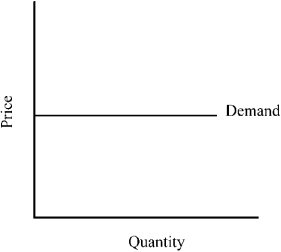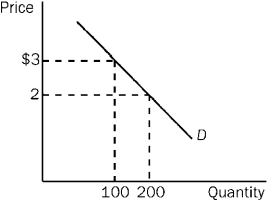Exam 7: Consumer Choice and Elasticity
Exam 1: The Economic Approach210 Questions
Exam 2: A: Some Tools of the Economist224 Questions
Exam 2: B: Some Tools of the Economist33 Questions
Exam 3: A: Supply, Demand, and the Market Process225 Questions
Exam 3: B: Supply, Demand, and the Market Process180 Questions
Exam 4: A: Supply and Demand: Applications and Extensions233 Questions
Exam 4: B: Supply and Demand: Applications and Extensions98 Questions
Exam 5: Difficult Cases for the Market and the Role of Government168 Questions
Exam 6: The Economics of Collective Decision-Making180 Questions
Exam 7: Consumer Choice and Elasticity223 Questions
Exam 8: A: Costs and the Supply of Goods223 Questions
Exam 8: B: Costs and the Supply of Goods8 Questions
Exam 9: A: Price Takers and the Competitive Process237 Questions
Exam 9: B: Price Takers and the Competitive Process23 Questions
Exam 10: Price-Searcher Markets With Low Entry Barriers216 Questions
Exam 11: A: Price-Searcher Markets With High Entry Barriers229 Questions
Exam 11: B: Price-Searcher Markets With High Entry Barriers25 Questions
Exam 12: The Supply of and Demand for Productive Resources200 Questions
Exam 13: Earnings, Productivity, and the Job Market109 Questions
Exam 14: Investment, the Capital Market, and the Wealth of Nations129 Questions
Exam 15: Income Inequality and Poverty136 Questions
Exam 16: Appendix: Government Spending and Taxation79 Questions
Exam 17: Appendix: the Economics of Social Security54 Questions
Exam 18: Appendix: the Stock Market: Its Function, Performance, and Potential As an Investment Opportunity70 Questions
Exam 19: Appendix: Great Debates in Economics: Keynes Versus Hayek8 Questions
Exam 20: Appendix: the Crisis of 2008: Causes and Lessons for the Future64 Questions
Exam 21: Appendix: Lessons From the Great Depression60 Questions
Exam 22: Appendix: the Economics of Healthcare68 Questions
Exam 23: Appendix:education: Problems and Performance60 Questions
Exam 24: Appendix: Earnings Differences Between Men and Women47 Questions
Exam 26: Appendix: the Question of Resource Exhaustion61 Questions
Exam 25: Appendix: Do Labor Unions Increase the Wages of Workers74 Questions
Exam 27: Appendix: Difficult Environmental Cases and the Role of Government63 Questions
Select questions type
Making drugs, such as cocaine, illegal results in a higher price than would be present if the drugs were legal. All else constant, the higher price results in drug users spending
(Multiple Choice)
4.9/5  (32)
(32)
Which of the following most directly reflects the law of diminishing marginal utility?
(Multiple Choice)
4.8/5  (34)
(34)
Suppose you are the manager of a local water company, and you are instructed to get consumers to reduce their water consumption by 10 percent. If the price elasticity of demand for water is -.25, by how much would you have to raise the price of water?
(Multiple Choice)
4.8/5  (42)
(42)
If a 20 percent reduction in the price of airline tickets between Chicago and New York leads to a 50 percent increase in the quantity of tickets purchased, the price elasticity of demand for the tickets is
(Multiple Choice)
4.9/5  (37)
(37)
If a 10 percent increase in income induced a group of consumers to reduce their yearly purchases of potatoes by 5 percent, for these consumers,
(Multiple Choice)
4.8/5  (36)
(36)
In the mythical nation of Oz, gasoline used to sell for $1 a gallon, and the natives purchased 100,000 gallons a week. Four years ago, the price rose to $3 a gallon, and the natives reduced their quantity demanded to 90,000 gallons a week. Calculate the price elasticity for this change. Today, gas again sells for $1 a gallon in Oz, but the natives are only buying 70,000 gallons a week. What gives?
(Essay)
4.9/5  (39)
(39)
Bob goes out to dinner three times per week, usually either to the local steak house or a Chinese restaurant in town. If the steak house were to raise its prices, Bob would probably (1) be less inclined to eat at the steak house and more inclined to eat at the Chinese restaurant when he did go out and (2) eat out fewer times per week because at the higher prices he cannot afford to eat out as much.
(Multiple Choice)
4.9/5  (37)
(37)
Jack, a music major, is perusing Jill's notes for her economics class, where she has written that "total revenues will rise with price rises only if demand is elastic." Jack tells Jill this is nonsense because firms can always increase their revenues by raising price. How should Jill respond?
(Essay)
4.8/5  (34)
(34)
Consider a consumer who purchases two goods, X and Y. If the price of good Y falls, then the substitution effect by itself will
(Multiple Choice)
4.7/5  (31)
(31)
Figure 7-3
 -Figure 7-3 depicts a demand curve with a price elasticity that is
-Figure 7-3 depicts a demand curve with a price elasticity that is
(Multiple Choice)
5.0/5  (36)
(36)
Tele-Com, Inc., a large cable TV company, tested the effect of a price reduction for the Disney Channel. It lowered prices from $10.75 to $7.95 and found that the number of customers more than doubled. This means the
(Multiple Choice)
4.7/5  (31)
(31)
If the price of tickets to Disney World increases 10 percent, and as a result, attendance falls by 15 percent, the demand for the tickets is
(Multiple Choice)
4.8/5  (30)
(30)
New York City increased regulated taxi fares by 17.5 percent and expected taxi revenue to increase by the same amount. The taxi commission believed taxi demand was
(Multiple Choice)
5.0/5  (33)
(33)
Use the diagram below to answer this question.  For this demand curve, the price elasticity of demand is
For this demand curve, the price elasticity of demand is
(Multiple Choice)
4.9/5  (37)
(37)
If the price of gasoline goes up, and Dan now buys fewer candy bars because he has to spend more on gas, this would best be explained by
(Multiple Choice)
4.8/5  (39)
(39)
Sally is on her college golf team and only uses Titleist golf balls. She states: "I don't care what the price is, I will only buy Titleists." Is this a believable assertion?
(Essay)
4.8/5  (23)
(23)
Terri currently consumes 10 hamburgers and 2 shirts per month. At her current rates of consumption, her marginal utility of hamburgers is 10 and her marginal utility of shirts is 50. If the price of hamburgers is $2 each, while the price of a shirt is $25, Terri
(Multiple Choice)
4.9/5  (29)
(29)
Why do economists use the concept of elasticity in addition to measurement of the slope of the demand curve?
(Multiple Choice)
4.9/5  (29)
(29)
Suppose there are only two goods, apples and oranges. What happens if the price of each good increases by 15 percent?
(Multiple Choice)
4.7/5  (29)
(29)
Showing 201 - 220 of 223
Filters
- Essay(0)
- Multiple Choice(0)
- Short Answer(0)
- True False(0)
- Matching(0)